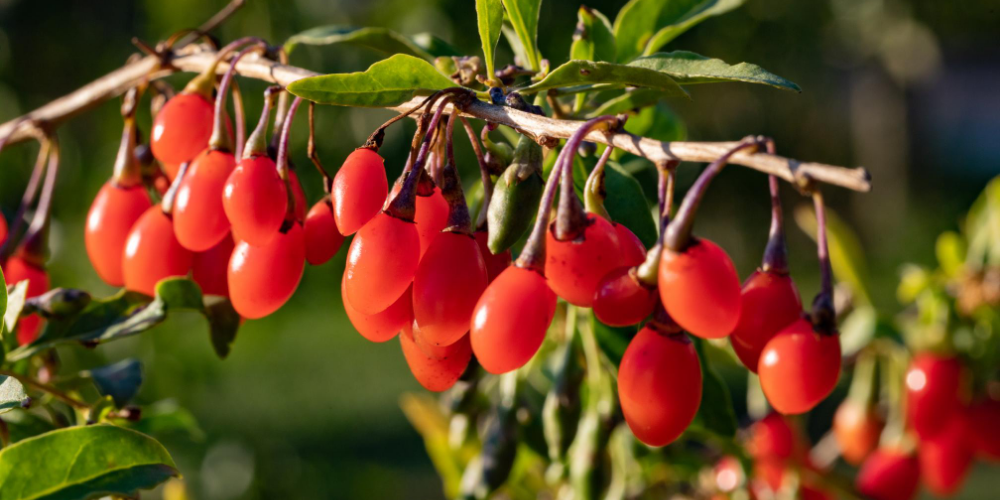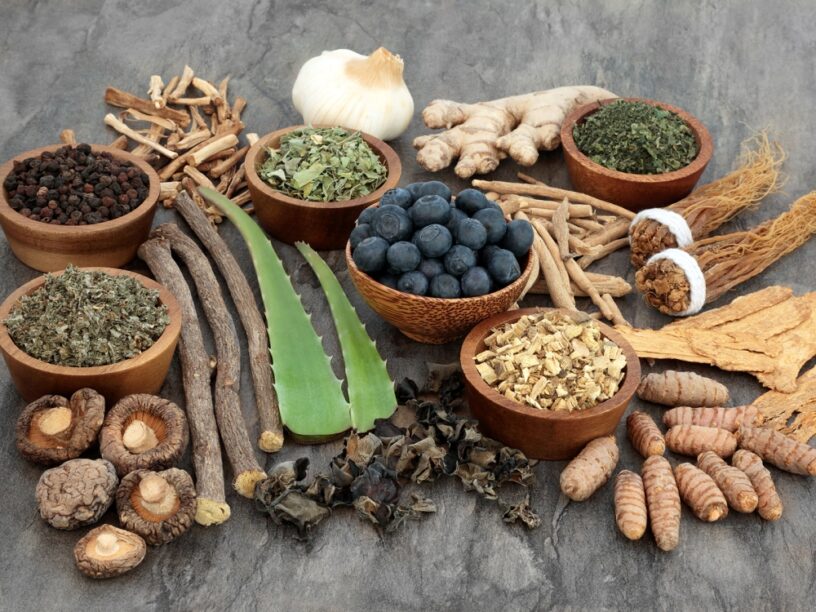Many people are looking for ways to be healthy that go beyond the vitamin bottle. They are looking for ways to increase vitality that are less about taking a pill and more about making different lifestyle choices, incorporating nutrient-dense foods, and utilizing the basic tenets of many ancient forms of healing, including herbalism, in daily life. During this quest for optimum health and vitality, many people come across the concept of adaptogenic herbs.


1. What Are Adaptogens?
The concept of plants with revitalizing or restorative properties that can enhance health has been around for thousands of years, although “adaptogen” is a modern word that has only been used to describe them since the 1940s. Many of the herbs that we know as adaptogens today were first used generations ago in Ayurveda (the traditional system of herbalism in India) and in traditional Chinese medicine (TCM). In Ayurveda, for example, herbs such as amla, Shatavari, and holy basil are classified as Rasayana herbs. Rasayanas are herbs that increase vitality and are believed to promote youthfulness and increase resistance to illness. In modern herbalism, we use these three herbs along with many other Rasayana as adaptogens. Like this original definition, most modern descriptions include the concepts that adaptogens:
- Are nontoxic
- Increase resistance to multiple stressors
- Help normalize physiological responses despite prior stress-related changes in the body
2. Top Adaptogens for Energy and Focus
2.1 TULSI


Tulsi is an Ayurvedic tonic herb that has seen around 3,000 years of traditional use and is considered one of India’s most powerful herbs. In addition to the rejuvenating properties of an adaptogen, folk medicine in India uses tea as an expectorant for bronchitis and to ease upset stomach and vomiting, and uses the snuff for congestion. Modern herbalists employ tulsi for the nervous system where there is mental fog, to support memory, to support recovery from head trauma, and as a nervine during depression. Tulsi’s immune system properties make it helpful for environmental allergies.
2.2 SHATAVARI


Mentioned in the Rig-Veda, which dates back to 1500 B.C.E., Shatavari is a type of wild asparagus used extensively in Ayurveda. The name of this herb has two possible translations, thanks to homonyms in the original Sanskrit: “She who has hundreds of husbands” or “One hundred roots.” Both names are surprisingly fitting. Shatavari is a beloved herb for women’s health and fertility and has a mass of thick, succulent roots below the deceptively thin stems above ground. Besides being used as an aphrodisiac and women’s tonic, Shatavari is also useful as a tonic when there is fatigue and poor appetite. It is traditionally used for inflammation of the bladder and urethra as well as irritable coughs with sticky mucus. Its soothing, demulcent properties make it useful for urinary, respiratory, and digestive health.
2.3 ASHWAGANDHA


Ashwagandha is an adaptogen that has a reputation as a soothing nervine, and as such, it can be well suited for someone who doesn’t want or need a stimulating adaptogen. Nervous system health challenges such as anxiety, fatigue, and insomnia from stress are all good reasons to consider ashwagandha.
This adaptogen appears to enhance endocrine function and can help support an underactive thyroid and support balanced functioning for the testes and adrenal glands. It is often used in Ayurvedic formulas to support fertility and vitality in men.
Ashwagandha has uses as a women’s herb, as well. It can be supportive during heavy periods because it is rich in iron, and has been used in Africa as a uterine tonic for women who repeatedly miscarry. Of course, this adaptogen also has potential uses for supporting the immune system. Ashwagandha has a balancing action and can be used in the presence of either hyper-or hypo-immune function.
2.4 MORINGA


Moringa is a tree native to northern India and hailed for its energy-boosting properties. The leaves contain vitamins, minerals, and amino acids that may help bring a natural burst of energy similar to coffee, but without caffeine. Regarded as one of the earth’s best energy enhancers, this nutrient-dense superfood has adaptogenic qualities, encouraging physical and mental balance. In fact, it can help regulate stress levels and bring a sense of ease. It is known for helping you feel alert and focused without the buzz.
2.5 GOTU KOLA


Gotu kola is an Ayurvedic tonic herb that is useful for cardiovascular health and as an immune system balancer, thyroid stimulant, and nervous system tonic. Gotu kola is a wonderful herb to use if you are looking for an adaptogen that supports mental clarity and focuses; there have been studies done linking Gotu kola with improved neural health for patients with Alzheimer’s disease.
One of the most fascinating aspects of Gotu kola as an adaptogen is the way that this herb’s immune-balancing effects combine with its vulnerable properties. A vulnerable herb is a plant that promotes the health of the skin and other tissues throughout the body. Because of this combination of effects, plus anti-inflammatory properties, it appears that Gotu kola can be supportive for people struggling with autoimmune conditions such as rheumatoid arthritis, inflammatory conditions of the digestive tract, and allergy-related skin conditions.
2.6 MACA


Maca is a root vegetable grown in Peru and is unusual in that it manages to thrive under the incredibly harsh growing conditions of the high elevations in the Andes Mountains. Although there is much interest in maca as a functional food and it is widely believed to be an adaptogen, tracking down human studies to confirm the potential actions of maca can be difficult. For the most part, it is valued for increasing libido and hormonal health in men and women, although the exact way that it does this is not understood. Some research has been done into the different varieties of maca (there are eight different types), and this work does show that each type has a slightly different profile of vitamins, minerals, and other factors.
2.7 CORDYCEPS


Although most mushrooms are a familiar sight on trees or fallen logs, cordyceps mushrooms are a type of fungus that colonizes caterpillars. After infecting and consuming the larvae of a ghost moth, the fungus fruits and makes a mushroom release spores. This mushroom, and what’s left of the caterpillar, are collected and dried for use as cordyceps. It is somewhat rare in the wild, so it was originally reserved for the emperor and the royal family. Poaching and environmental concerns are a problem thanks to the increased popularity of this herb, but several companies now produce excellent cultivated cordyceps grown on soy instead of caterpillars.
Traditionally used to support the health of the kidneys and the many concepts believed to be affected by kidney health, cordyceps are used for infertility, sexual dysfunction, frequent urination, night sweats, dizziness, ringing in the ears, and fatigue. More modern applications include use for athletic performance, as an immune amphoteric, and as a kidney and lung tonic.
2.8 RHODIOLA


This adaptogen is a succulent that grows in cool, northern climates. It is native to Canada, Russia, and Scandinavian countries. It grows best in full sun and dry, sandy soil or a rock garden. Rhodiola is part of the official Russian pharmacopeia as an antidepressant and nerve tonic. Traditionally, this herb was used to increase mental stamina and physical endurance, to boost the immune system during winter, and as a fertility and endocrine tonic for men and women.
Rhodiola can help support the immune system in athletes, as hard training can sometimes cause a decline in immune function. Rhodiola may also help balance blood sugar levels, help with fertility and reproductive health in both sexes, strengthen the heart, and protect the heart from stress-related damage.
2.9 ASIAN GINSENG


Asian ginseng is one of the most stimulating of the adaptogens, which can be a good thing for extremely worn-out or exhausted people who are also addressing lifestyle and diet to support healthy energy levels. However, healthier individuals, especially those who are driven, extremely busy, and fueled by caffeine, may find that it is a bit much. Like other adaptogens, ginseng has an influence on immunity and the adrenals, and may also help protect heart health thanks to high antioxidant levels. Asian ginseng is almost extinct in the wild of its native habitats in Korea and northern China.
2.10 GOJI


Goji berries grow on a perennial vine and are native to China. They have naturalized in Hawaii, and there is a related species that grows in the southwestern part of the United States. Goji plants aren’t especially picky about growing conditions and do well in average soil with good drainage and full sun. In traditional Chinese medicine, liver tonics like goji are often also used to promote the health of the eyes. Goji has a reputation for assisting with poor night vision; dry, red, or painful eyes; glaucoma; macular degeneration; excessive tearing; and cataracts, especially in formulas with other herbs. This adaptogen is considered a nutritive tonic for the liver, kidneys, and blood, and the antioxidants in goji can help stabilize and strengthen veins, capillaries, and arteries.
3. Use Adaptogens Safely
Please treat adaptogens with the respect they deserve as potent allies for health, you can incorporate these wonderful herbs into your daily life and enjoy their many benefits. It becomes doubly important to know safety information on the herbs you work with if you are on prescribed medications. In some cases, herbs can affect your metabolism or alter the way the liver processes medications. Herbs, including adaptogens, may have a synergistic or antagonistic influence when taken with pharmaceuticals. It’s best to do some careful research and speak with your doctor or pharmacist before proceeding if you take a daily prescription medication.
3.1 Watch Serving Sizes
When you add herbs to your diet, it’s important to remember that more isn’t necessarily better. Each individual herb has a particular safe range that shouldn’t be exceeded, and you should be careful not to combine full servings of several herbs that have similar actions. For instance, it’s better to take one serving of a formula of herbs that promotes a good night’s sleep than to take a full serving of four different individual herbs that all promote sleep. Adaptogens are no different. They are safe herbs, but taking too much of one or more at a time or over the course of a day can leave you feeling jittery or aggressive. With prepackaged, off-the-shelf herbal supplements, it’s important to follow the recommended serving size and directions that come with the product. Make sure that you know the basic guidelines on correct serving sizes for the preparations you choose to make at home.
3.2 For Adults Only
It may be tempting to incorporate adaptogens into the diets of the whole family, but what may be a wonderful herb for an adult may be less desirable for a child. Some adaptogens appear to have a very potent influence on the endocrine system and may alter hormone levels in adults. Because children are still growing and their endocrine system is developing, the use of adaptogens with preteens and even teens is a very complex subject. There are a few adaptogens that are exceptions to this rule, but in most cases, it would be best to speak with a qualified herbalist about the child-specific situation before making the decision to add adaptogens to his or her diet.






Leave a Reply